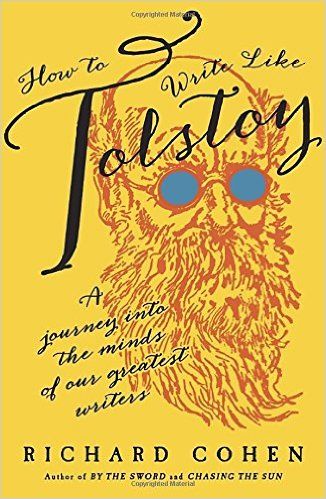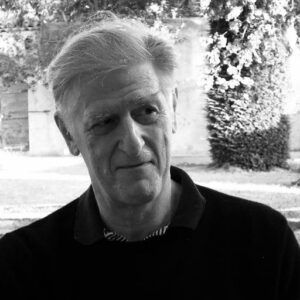
 With his new Random House release, “How to Write Like Tolstoy: A Journey into the Minds of Our Greatest Writers,” author Richard Cohen shines a light on history’s greatest storytellers. This spectacularly written how-to is not your average road map to becoming a pro.
With his new Random House release, “How to Write Like Tolstoy: A Journey into the Minds of Our Greatest Writers,” author Richard Cohen shines a light on history’s greatest storytellers. This spectacularly written how-to is not your average road map to becoming a pro.
Throughout the pages of this delectable dish of writing advice, Cohen delves into the creative intellect of Virginia Woolf, F. Scott Fitzgerald, Vladimir Nabokov, and the like, serving techniques like character development, voice and point of view.
Based on outstanding research and a voice you can’t shake off, reading a book about writing has never before been this thrilling. Bookfox reached out to Cohen through email, asking a few burning questions.
Bookfox: What advice do you give those writers who are having difficulty finding their own “writing tricks” such as Tolstoy possessed according to Ivan Turgenev?
Cohen: Turgenev criticized Tolstoy for giving the minor characters in his novels some distinctive quirk or physical detail — “the pointed tip of Alexander’s boot,” or “Speransky’s laugh,” suggesting he knew them well. But many of the best novelists we know do that, and it’s a tough criticism to call it “a charlatan’s trick,” as Turgenev did.
Bringing minor characters to life is difficult, though, if they are not to seem caricatures or cardboard cutouts. One should always try to see the world through the eyes of each of one’s creations, so they will come across as real. The more of a complete world you can invent for each person, then the more you can pick and choose the elements you want to include in your story. Always “know” far more about each character than you actually use. Get to know their secrets.
BF: Do you have a unique way of inventing characters such as Tolstoy creating a back story for each of his barn animals?
Cohen: It is up to the individual author to decide how much description to give: some like to provide as much as possible as soon as possible, which is not necessarily wrong but can clog up the narrative.
Names are important. Nabokov took immense pains before settling on the name of Lolita. Charles Dickens, who invented thirteen thousand characters, would pore over the Transactions of the Privy Council lists looking for unusual names, while “Copperfield” came from a sign he noticed on a shop in a London slum.
A writer can tell his or her readers what a character is like (either via the narrator, or another character, or by the character themselves); or leave it to the reader to infer such information from the character’s thoughts, actions and speech.
The publisher and novelist Sol Stein in Stein on Writing quotes the sentence, “She always stood sideways so people could see how thin she was.” The description does double duty, letting the reader see the character’s attitudes while at the same time we learn that she is lean.
BF: What would you suggest to a writer who is not happy with anything they have written? What would you suggest to a new writer who believes that their writing is not “good enough” for the world?
Cohen: All writers are unhappy with their work at some time or another. And to a degree rightly so: the vast majority of us don’t get things right the first time, and need to revise, rethink, polish.
Experience counts for a lot: knowing when to leave alone — one doesn’t want to be like Joseph Grand in Albert Camus’s story The Plague, who rewrites the first sentence of his novel eternally, with only minimal variations.
Otherwise, the views of friends and friends and of other writers can be of huge service, helping to refine a writer’s judgment, although in the end it’s the writer who has to decide whether what they have written is worth going on with. Self-belief can be the devil in disguise; or a valuable technical skill telling you when to stop or when to carry on.
BF: Tolstoy explains the “power of description” through Homer’s brief yet visual description of the character Helen. Do you find that readers are better off imagining what a central character looks like without a physical description or is it imperative that a writer provide a list of traits to satisfy the reader?
Cohen: The simplest way to introduce a character, common in older fiction, is to give a physical description and biographical summary, but today writers tend to avoid giving lengthy descriptions so as not to influence the reader unduly. Jane Austen, for one, expended little energy on the appearance of her leading romantic players. Her characters are “handsome” or “pleasing” or “not at all handsome,” leaving her readers to conjure up the rest. Anyway, whether a character is handsome or beautiful can depend so much on the eye of the beholder that it may be best to err on the side of minimal description. But it’s important to trust your reader — which includes allowing them room to do some imaginative work for themselves.
BF: When hooking an audience with the opening sentence of a novel, you describe to readers that “different fish require different bait.” How do writers know exactly what fish they should be trying to catch?
Cohen: Nineteenth-century authors were quite happy with long, slow openings confidant that their readers would accept a leisurely way into the story without having to be immediately thrown a piece of red meat in the form of some hugely dramatic happening.
That can still hold, although with our reduced attention spans getting a quick pay-off is somehow expected. But if one is writing a mystery or suspense story there is increased expectation for an exciting beginning. Sometimes just telling an exciting story can be enough; for a different kind of reader — a different fish — establishing a tone of voice that beguiles you is more important.
BF: How do writers learn to trust their own voice and the content they write?
Cohen: Experience, I am afraid. Which is not just writing, writing, writing, but constantly reading too. It can help to read their work aloud, for themselves to hear as well as their nearest and dearest. How does one learn to play a particular shot in tennis? There are technical considerations; but if the ball goes over the net, or better still wins the point outright, then one learns to trust that particular way of making the shot. Not all one’s sentences can be outright winners, but one learns to recognize when they land in or out of court.
BF: Should writers write for themselves or for an audience? What is your purpose for writing?
Cohen: Only a fool doesn’t write for money, said Dr Johnson — but he was a paid journalist. One can write for one’s own pleasure, as Emily Dickinson mainly did; but most people write for an audience, ideally for some perfect reader.
My purpose in writing is to earn money; to reach an audience who may enjoy my work; and perhaps particularly for my closest friends and family to think well of me. Yes, my books have a message, an argument, so to convince people of what I saw is important too. Writing doesn’t have to have one single purpose.
BF: Some authors plan and have certain “authorial tricks” that bring the reader closer to the central characters. What advice do you suggest to those writers who just play it by ear?
Cohen: I’m not sure what “playing it by ear” really means. Winging it? My own experience is that one wants a marriage of planning, having a sense of what your characters are like and what you want to have them do, and an element taken from jazz, where you let your conscious mind slip and take in ideas and intuitions that lie just below the surface of consciousness, so that what you write may surprise you — in a good way — yet it has been part of what is in you to create all along.
BF: Should a character’s name and physical description carry symbolism throughout the novel, and if so, what do you suggest to writers who are thinking too hard on their decisions?
Cohen: I feel about symbolism the same as I do about Bar-B-Q sauce — better laid on lightly, and make sure the basic meat is of good quality.
Dickens and Anthony Trollope are famous for choosing names to underline what their characters were like: Thomas Gradgrind, Scrooge, Sir Orlando Drought, Uriah Heep, Lord Decimus Tight Barnacle, The Artful Dodger, Dr. Pessimist, Wackford Squeers, and so on. One can overdo things. Ibsen used to have a saucer on his writing desk filled with miniature animals and so on, and would pick up an animal and use it as a symbol. I wish he’d thrown the whole lot away.
BF: Do you have any advice for those who develop writing envy when they look at another writer’s achievements?
Cohen: We all feel envy from time to time. That’s not the end of the world, though it comes best when mixed with heavy doses of admiration. In itself envy is not productive, but if it can be a spur to driving oneself on to greater and better effort then it has served a positive purpose. Don’t wallow, in other words; turn a negative emotion into one that helps inspire your own work.
